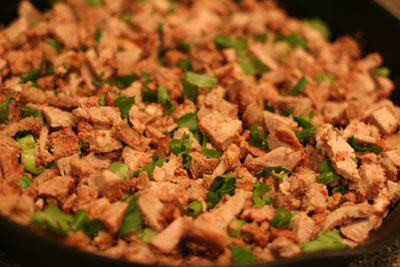 Sisig is a famous Filipino hangover killer. I first heard of SiSig while watching an episode of Anthony Bourdain's No Reservations. It looked really tasty so I searched around for what ingredients are usually included and put together this recipe. I'm not sure if this version of SiSig tastes anything like what you would find in Manila, but it does taste great.
Sisig is a famous Filipino hangover killer. I first heard of SiSig while watching an episode of Anthony Bourdain's No Reservations. It looked really tasty so I searched around for what ingredients are usually included and put together this recipe. I'm not sure if this version of SiSig tastes anything like what you would find in Manila, but it does taste great.In the Philippines, they use liver and beef tongue to make SiSig. However, these ingredients are not as readily available in your average grocery store here in the United States and the thought of using these ingredients may not seem that appealing anyway. So I put my German heritage to good use and used braunschweiger instead.
SiSig is a great appetizer or side dish and should definitely be served with ice-cold beer.
Ingredients:
1 to 2 pound pork shoulder
1/2 tube of braunschweiger (pork liver sausage) removed from casing
2 cups water
1 cup pineapple juice
kosher salt, to taste
black pepper, to taste
garlic powder, to taste
3 tbsp canola oil
3 green onions, diced
cilantro
marinade ingredients
1 large yellow onion, chopped
7 dried chili peppers
1 Serrano pepper, deseeded and diced
1/4 cup vinegar
1/4 cup apple cider vinegar
juice from 1 lemon
1/4 cup pineapple juice
2 tspn fresh ginger
3 cloves garlic, diced
1 tspn black pepper
1 bay leaf
kosher salt, to taste
Preparation:
- Cut the pork shoulder into large 4 to 5 inch chunks so that most of the meat is trimmed from the bone.
- In a large pot, add the pieces of pork and bone, water, pineapple juice, salt, and pepper.
- Bring to a boil and then simmer for an hour or until meat is tender.
- Drain the pot and let the pieces of pork cool to room temperature. Discard the bone.
- Light the grill.
- Cut the pieces of pork into smaller 2 to 3 inch pieces.
- Put the pieces of pork on metal or wood (soaked in water) skewers.
- Baste the skewers of pork with olive oil and season with a little salt, pepper, and garlic powder.
- When the coals start to turn white, place the skewers on the grill and cook until brown and crispy.

- Remove the pork skewers from the grill and let cool.
- In a large bowl, combine the garlic, ginger, onions, vinegar, apple cider vinegar, lemon juice, chili and Serrano peppers, salt, pepper, and bay leaf.

- Add 1/2 of the pieces of grilled pork to the marinade and refrigerate for 1 hour.
- Cut the other half of the grilled pork into small 1/2 inch pieces.

- Add these pieces to a large skillet along with the braunschweiger and 3 tbsp canola oil.
- Heat the skillet over medium for about 10 minutes stirring the ingredients together so that they form a hash type mixture. Remove from heat and set aside.

- After an hour has passed, remove the pieces of grilled pork from the marinade and cut them into small 1/2 inch pieces. Strain the juice from the marinade and set aside for later.
- In a large bowl, combine the hash mixture, the pieces of pork that came from the marinade, and the green onions. Stir all of the ingredients together.
- Serve with a garnish of chopped cilantro and pour some the juice that you reserved from the marinade over the dish for extra flavor. It's OK to use the juice from the marinade as the pork was cooked before it was added to the marinade mixture. Also, don't forget to serve with ice-cold beers (San Miguel if you have it).
 Philippines
Philippines


Oh YUM! There's a restaurant in the Philippines called Gerry's Grill that specializes in Sisig. It's awesome with beer and they serve it on a sizzling plate with a squeeze of Philippine lime (calamansi)
ReplyDeletethis looks yum! but we filipinos usually use pork face (cheeks, snout, ears... and some other pig parts I'd rather not think about myself) to make a wonderfully spicy, tangy porky hash of sisig :) I particularly like to scrape the stuff sticking to the hot plate. really good as pulutan (drinking food) :D
ReplyDeleteas for beef tongue, we use that for lengua estofado which is more spanish than really native filipino.